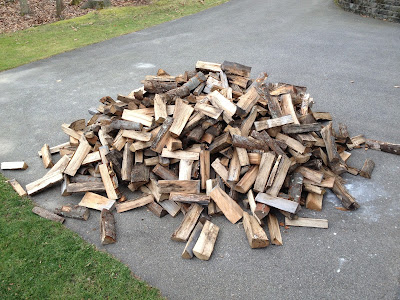The round trip hike takes about 5 hours. Today we used snowshoes, although the lower one-third of the trail was easily passable in bare boots as the trail was well-packed. A large red pine tree -- more than 14 inches in diameter -- had recently fallen across the trail, some time after the latest snowfall Saturday night. This was evident from the fresh sandy, soil lying on top of the snow.
As we climbed over the trunk of the red pine, we wondered about the sounds created when the tree roots were ripped out of the ground and the thud of the great trunk falling to earth, although glad that we were not around when it happened.
The trail passes through a beautiful pine and hemlock forest about mid-slope above Kearsarge Brook.
On our previous treks up this mountain, I had not noticed that many of the red pines were dead or dying farther upslope. Many stand as dead snags (the trees with the whitish trunks in the next photo), some still have bark on their lower trunks.
The trail emerges into a pine-dominated ledgy area with the first good views of the Moats and Mt. Chocorua to the southwest.
The trail then circles around to the northwest of the peak and passes through a spruce-fir forest with lots of spruce regeneration. Here is where the snowshoe hare hang out, their tracks criss-crossing the trail from one spruce thicket to another. The northwest side is shaded and cooler, with more snow cover.
At last the trail curves back around to the south for the final climb to the peak - the old fire tower beckoning the hiker to take the final steps.
It was less windy and slightly warmer (about 25F) than we expected, so we hung around on top for a bit, enjoying Kodi's exuberance. He loves to roll on the icy snow and frolic in the cold wind.
Then there was the small ice formation -- a dancing bear perhaps?
As well as the rime ice on the tower and the east-facing tower windows.
During our ascent we had blue sky and moderate winds with occasional gusts. By the time we began our descent just past noon, the clouds started to thicken. This did nothing to dampen our spirits for ending 2012 with a fine hike. And thanks to my mother and father for giving Srini a box of penuche (brown sugar fudge) for Christmas that we carried and ate all the way up the mountain. I think it's now my favorite winter trail food - soft and smooth and full of quick energy.













































